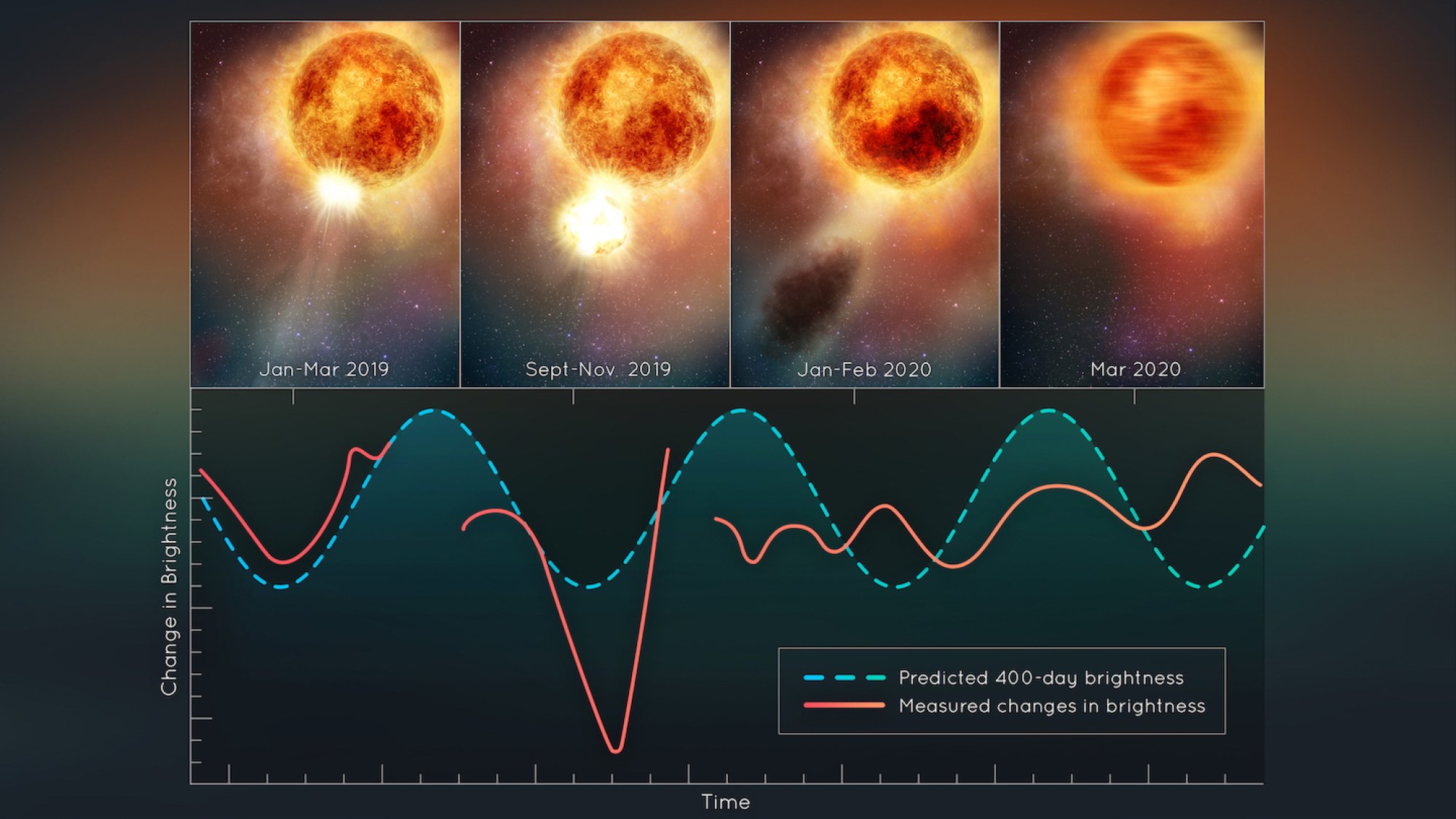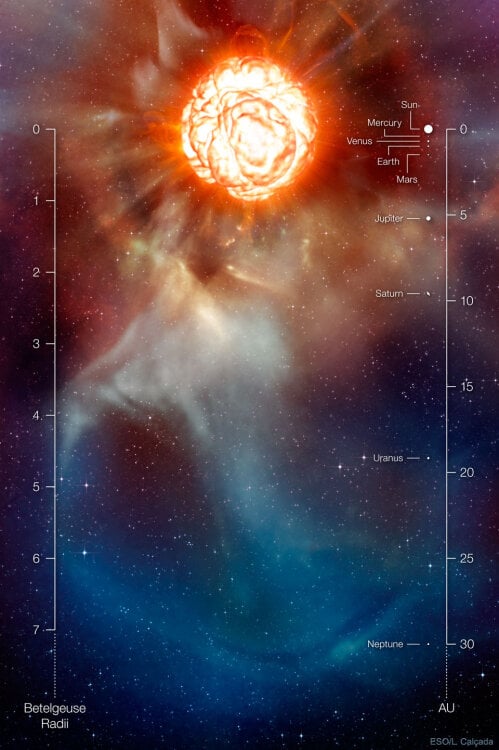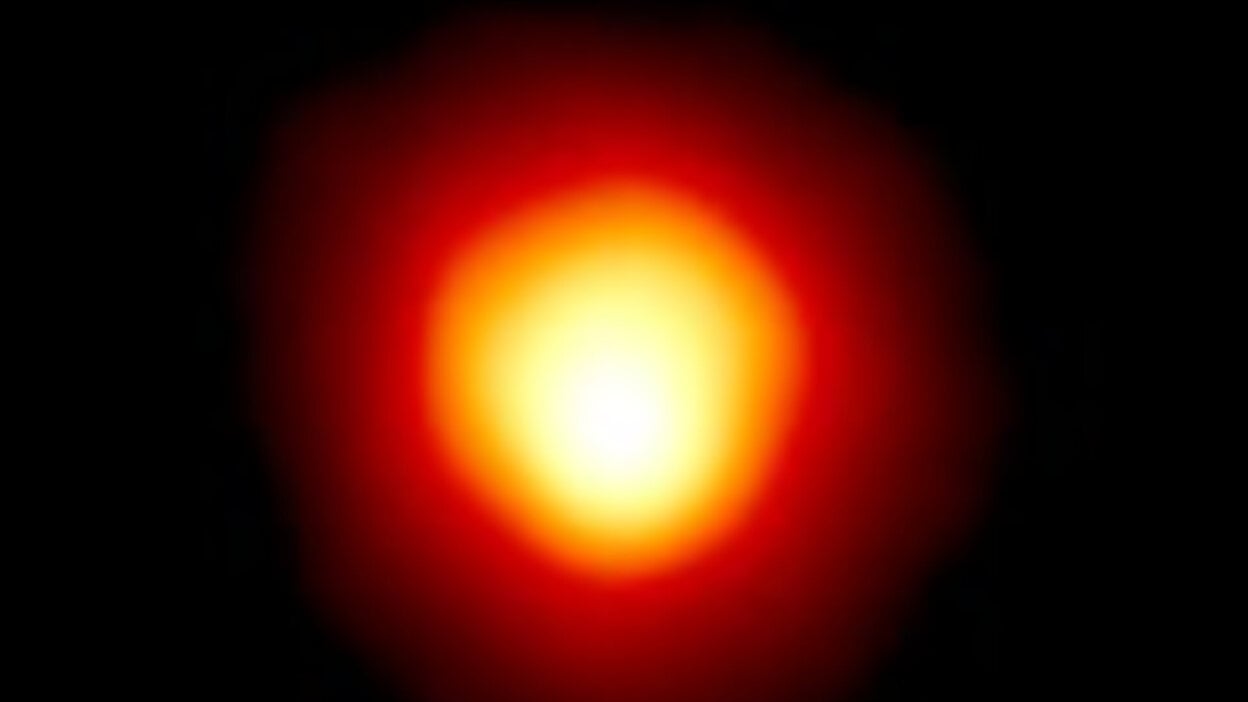Humanity has marveled at the vivid star Betelgeuse for many millennia. Over two thousand years ago, this imperious red object in the constellation Orion caught the eye of the Roman poet Horace:
But see, with what a troubled glare Orion's star is setting there!
Today the colossal, easy-to-find star — so large that it would reach to Jupiter in our solar system — continues to intrigue us. And unlike most stars, we can see it changing, in part because it's relatively nearby in our galaxy. Betelgeuse is known for being a type of "variable star," meaning its brightness fluctuates, at times dramatically, as it inches toward an eventual grandiose collapse and stellar explosion, known as a supernova. In recent years, the star has grown noticeably brighter.
"People love Betelgeuse," Heidi Morris, a scientist at Los Alamos National Laboratory and the president of Pajarito Astronomers, an astronomy club, told Mashable. "It's been doing these brightness fluctuations for a very long time."
(What's more, recent research suggests that Betelgeuse may have a small stellar companion, "Betelbuddy," which forces nearby dust out of the way and contributes to pulses in Betelgeuse's brightness.)
Yet lately these fluctuations haven't been normal. Typically, Betelgeuse varies in brightness over 400 day cycles. But since violently blowing off a hunk of its atmosphere in 2019, these oscillating periods have shortened.
Tweet may have been deleted
But don't get too excited. This almost certainly isn't evidence of a bloated star on the literal brink of a supernova.
"People love Betelgeuse."
Still, Betelgeuse is a red supergiant star that has lived hard and will die young. It's just some 10 million years old — while the sun is 5 billion years old. It's a colossal star in the final stages of its fast-paced evolution. When it inevitably runs out of fuel, the core will collapse under the weight of its immense mass, and create an explosion that can outshine galaxies. It will happen. But you, me, and everyone else would like to know when.
When will Betelgeuse explode?
The cold, hard truth is, it's unknown when Betelgeuse, at some 640 light-years away, will collapse into a supernova.
"We don't have a way of predicting when stars will explode," Or Graur, an associate professor of astronomy at the University of Portsmouth who researches supernovae, told Mashable. "We have no idea when Betelgeuse will explode," added Graur, who wrote the book Supernova.
"It really is uncertain," agreed Los Alamos' Morris. "We haven't had a lot of supernovae to study in human history."

There is some evidence that Betelgeuse might not explode for a long, long time. Historical records indicate Betelgeuse has become redder over the past two thousand years, explained Jason Ybarra, the director of the West Virginia University Planetarium and Observatory, who researches stars and the history of astronomy. That would mean Betelgeuse only evolved into a red supergiant relatively recently (in cosmic terms), so it might take quite a while for the star to completely exhaust its fuel.
"To answer the question the best I can, Betelgeuse is probably not going to supernova any time soon," Ybarra told Mashable.
Once a star becomes a red giant, it has a lot of cooking to do. Under the immense pressure in its core, heat fuses helium into carbon. After thousands of years, it then fuses carbon and helium to create oxygen, and the forging process continues, ultimately creating metals like iron. Right now, Betelgeuse is probably at an earlier stage in this cooking process, explained Morris, as the analysis of chemicals in the star's atmosphere suggests it's fusing helium to carbon in its core. (We can't see inside mighty Betelgeuse.)
NASA has recently written that Betelgeuse won't explode for "another 100,000 years." Indeed, this could happen. But that's far from certain. More observations might suggest the star could defy these expectations. Before 1987, for example, astronomers thought only red supergiants could blast into a supernova. But in 1987, a giant blue star in another galaxy exploded.
We clearly still have a lot to learn. We might be surprised. Watching Betelgeuse, and other giant stars, will give us a better answer.
"I would hesitate to say it will do nothing in 10,000 years," said Morris. "We should keep our eye on it and let it inspire us to move forward scientifically."

What will we see when Betelgeuse explodes?
When Betelgeuse eventually explodes, it will astonish the world, or whomever is watching.
You'd be able to see the star change with the naked eye. Betelgeuse will get progressively brighter at night. After a few days, it will peak in brightness. This will last for around 100 days.
"It will be the brightest star," explained Graur. "You would even be able to see it by day." Research predicts the Betelgeuse supernova would be 15 to 250 times brighter than Venus, currently the second-brightest object in the night sky. Then it will begin to fade over hundreds of days, until it winks away into the black ether of space (binoculars and telescopes will be able to spy it for longer).
But Betelgeuse isn't the only red supergiant in our galaxy. Others, like Eta Carinae, might erupt in the sky first. In a galaxy the size of the Milky Way, statistically there should be a supernova every 50 or so years, explained Graur. But we haven't seen one actually happen in 400 years, though we've observed remnants of explosions.
"Statistically, we're overdo," Graur noted.
"Statistically, we're overdo."
Any explosive event likely won't be sudden, like detonating a bomb. There could be signals, such as smaller eruptions before the grand finale.
Keep your eyes to the sky. "We don't know where the next supernova will come from," said Graur.
Topics NASA





























